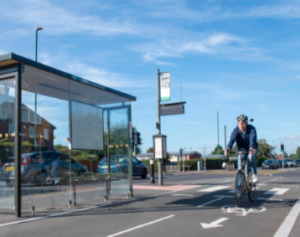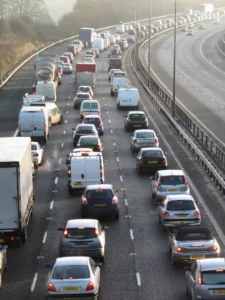As he announces his departure as Chief Executive in the new year, Highways England’s Jim O’Sullivan talks to Adrian Tatum about RIS2, its Delivery Plan and why safety has to be an on-going commitment.
There’s a sense that it might be the beginning of a new era for Highways England. The Road Investment Strategy 2 (RIS2) has started, a new Delivery Plan launched and the search for a new Chief Executive has begun after the recent announcement that Jim O’Sullivan will step down in the new year.
It could be the right time for change as well. Highways England in its current state as a government-owned company is five years old now and there are many signs that it has started to mature into a much more effective organisation than its predecessor the ‘Agency’.
Some of that of course is down to Jim O’Sullivan who has led the organisation through that transition period and beyond of making it more efficient and more effective along the way.
Although he admits things aren’t perfect, he leaves at a time when the organisation’s reputation is growing for the better. “It was a case of me leaving at the right time when the organisation is on the up with a stable promising future,” he says. “Highways England is not the finished article. But at the start of this process the one question I was asked the most by everyone was ‘why is Highways England a good idea?’ but I think most people would agree they don’t want to go back to dealing with the old ‘agency’ now,” he says. “It is a promising time for us. The last five years has seen the start and successful completion of RIS1, RIS2 is signed off and has started despite the challenges of the pandemic.”
Mr O’Sullivan says one of the things he is most proud of is the recent early completion of the A14. “To see a £1.5bn project be finished early and arrive on budget is pretty impressive,” he says. He also says managing to complete £1.4bn of efficiency savings over roads period 1 is another.
But there is still work to do. He admits things ‘could have been done differently’ over the way the organisation planned its communications around smart motorways. “If I look back… the smart motorway communications could have been better. There was too much focus on the new technology and perhaps it could have had a clearer, simple message for drivers instead, but we have invested £5m in communications as part of RIS2 to address that,” he says.
If Highways England was to be given a school report relating to safety it would probably be marked as ‘A’ for effort but a ‘B’ for attainment right now. The recent Office of Rail and Road (ORR) report on Highways England’s performance said ‘further hard work’ was required to meet safety targets by the end of 2020 – a 40% reduction in killed or seriously injured, but Highways England already had ‘an enhanced focus on improving safety’ on its network. As of July, when the report was issued, the latest figures from 2018 shows a 30% reduction in KSIs from the baseline figure. The report said further investment is needed to meet its longer-term goal: that nobody should be harmed on the network by 2040.
According to the ORR, in 2018, there were 250 deaths on the strategic road network, which is 14 (6%) higher than in 2017. Of these, 85 deaths were on motorways – a reduction of six (7%) from the previous year. However, rates of fatalities and serious injuries are lower on the strategic road network than on other roads in England. In 2018, the strategic road network carried 34% of all traffic in England, but accounted for 16% of all road deaths.
Mr O’Sullivan says he is proud of the government-owned company’s safety record and things are still improving. “Another thing I am very proud of is that during RIS1 we were able to reduce serious injuries to traffic officers and regional control centres colleagues by 95% which is an amazing achievement. Added to that, over the same period, the incident rate to our supply chain was reduced by over 50% – that’s quite an achievement as well,” he adds.
“It has been really good to see over the last five years that Highways England has embraced safety as an imperative and has taken it to heart right the way through the organisation and through the continuous improvement approach of our contractors. It hasn’t been about a ‘hearts and minds’ conversation more about an imperative mindset where people have taken responsibility to drive change. Safety can only go one way and we need to continuously seek to improve,” says Mr O’Sullivan.
“We continue to look for new technology and working practices that can keep both the road user and roadworkers safe. It is important that both feel safe in each other’s company and that interface will be something we will continue to work on. Incursions has been a particular focus recently and we have been using automated airlocks and similar systems more extensively across our projects which has also seen road workers and traffic officers working more closely together,” he says. “One of the reasons why we have the safest roads is also down to our planning when we build them as well, such as getting the right gradients and sightlines in the pre-construction phase,” he adds.
But what about safety and smart motorways, is he confident that any past problems will be addressed or is it more about getting the communications right so people know exactly how to behave on them, reducing risk?
“I get frustrated when everyone focuses on smart motorways. Every death or injury on a motorway is a tragedy and we need to keep on finding ways to improve this as a priority but there are around 1,500 deaths on all roads in the UK every year compared to about eight or nine on smart motorways and I think it is just as important we (as a nation) do more about that also,” he adds.
In RIS2 the funding of safety, and in particular innovation and development, is provided via a £140m Safety and Congestion designated fund for 2020-25. At first glance this might seem a small percentage of the total £27bn made available for delivery of RIS2 but that isn’t the only way of funding safety work moving forward. “Our Safety Delivery Plan is now integrated with our overall Delivery Plan which means that safety is at the heart of every project we deliver,” he says.
He says that the new Delivery Plan for RIS2 is ‘practical, deliverable and clear’. “In some case the schemes we had in RIS1 were relatively immature but RIS2 will see larger schemes such as the Lower Thames Crossing and the work around Stonehenge come to fruition. We have a better understanding of the specs of some of these schemes before we start and obviously a mature way of working now.”
He points towards several maintenance projects, the replacement of old concrete roads and of course, the continued investment in smart motorways including the roll out of new Stopped Vehicle Detection technology. “The way we are working now means the same teams work on the smart motorway projects which means there is on-going learning as they go from one scheme to another and a focus on delivering efficiencies and implementing new innovation as well.”
Mr O’Sullivan also says RIS2 aligns ‘quite well’ with the Government’s overall intention to continue to invest in infrastructure as a means of boosting the economy and ‘levelling up’. “The Government has really embraced RIS2 and the work is very evenly distributed across the country. There is a big spend in the north and in the Midlands and the Lower Thames Crossing will provide a necessary alternative to crossing the river via the Dartford crossing, reducing journey times significantly. I think this is a truly national delivery plan,” he says.
Another headline of the delivery plan is the 64,000 jobs that will be supported alongside the £14 billion worth of projects as part of RIS2. On top of that the Delivery Plan will see more than 50 road upgrades, and invest almost £1 billion on broader projects to improve roads for the communities they serve, such as conserving cultural heritage or strengthening flood resilience, and improving access for walkers, cyclists and horse riders. It will deliver a series of major upgrades, such as improving: access to the Port of Liverpool; capacity on the A19 in Sunderland supporting local plans for an international advanced manufacturing park; journey times on the A38 with a scheme for the Derby junctions in the Midlands while providing extra facilities for walkers and cyclists; and the A12 in the East, aligning with local authority development plans.
“I’m pleased we are able to increase our spend to support so many sustainable jobs for people that are long-term,” he adds. “It is also great to see a focus on asset delivery in the plan and the intention is to improve our understanding of the asset in a really detailed way. So far this has been embraced in all of our regions and future plans fall in line with the ORR’s call for inter-regional cost benchmarking than can be learnt, built on and used in every region and therefore delivering something that is good value for the taxpayer as well,” he says.
There is also a further intention to continue to invest in new technology. In June Highways England launched a 15-year plan to accelerate the use of technology in infrastructure. It set out a ‘roadmap’ working with TRL and the Infrastructure Industry Innovation Partnership (i3P), to create a vision where the use of CAP techniques will become standard industry practice by 2035. But why now?
“The technology is really starting to prove itself. Fewer people are needed to operate it – therefore you are removing the risk of operatives working on live roads and there is a cost saving as well – there will be many other safety benefits as well as we investigate further what can be achieved here.
“We are getting to the point where automation is really helping deliver data that is becoming very useful. We are getting close to the point where every time we lift a bucket of earthworks we know how much we have lifted in total every day. It is this sort of thing that will help us drive more efficiencies and plan more effectively,” he says.
So, as this era of Highways England draws to a close, it makes you wonder what sort of leader the organisation needs next? Whoever it is will no doubt bring their own style and in time impose their own priorities but they will also be glad they are taking over now compared to five years ago, which probably says the most about Jim O’Sullivan’s legacy, that’s for sure.






















